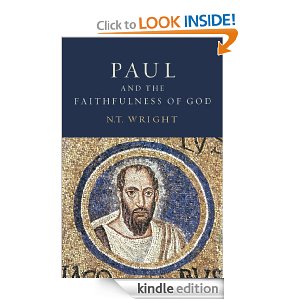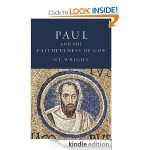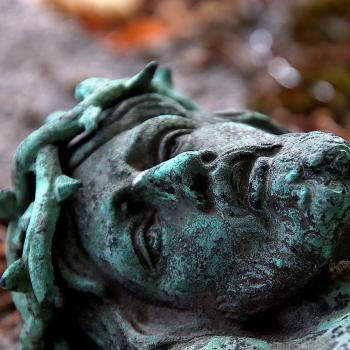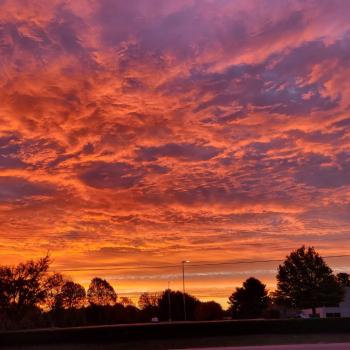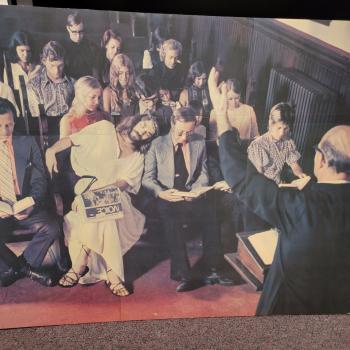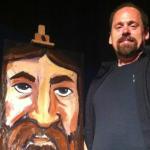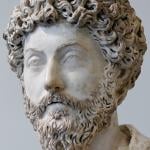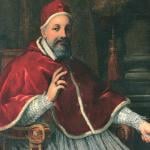Under the heading of the large plot about God and creation does come the theme which crops up some seven times in Paul’s letter— the Dominion of God, or God retaking back his creation from the powers of darkness. In other words, God is not just interested in saving humans, he’s interested in the renewal of his whole creation (see Rom. 8). Thus Wright stresses that the larger outer story about God and creation is a story about judgment (p. 481). Judgment is to be seen as a positive thing. Passing judgment is seen as a good thing– restoring equilibrium to creation by countering and judging the world, the flesh, and the devil. The term basileia can refer to the current saving reign of God in a person or community’s life, but with a future verb it regularly refers to the realm of God, when he retakes the earth through Jesus, and ‘the kingdoms of this world become the kingdoms of our God and of his Christ’. Meanwhile we pray ‘thy kingdom come’ indicating it has not yet fully done so. “Judgment is what happens when the creator says ‘No’ to all that stands out against his good, positive, purposes for his world, in order to say ‘Yes’ to that world itself, in all its fullness” (p. 483).
Within the larger outer plot are several sub-plots— Wright lists 1) humans their vocation, failure, rescue, reinstatement; 2) Israel the people called to be light to the world; 3) Jesus the Jewish Messiah who must succeed where Israel failed in being the light of the world. The human plot is related to the outer plot, because humans were given the task of stewardship of creation in the first place. If humans fail to do this, then God’s plan for creation and its caretaking is thwarted. Enter the story first of Israel, then of Christ (and I would add, and finally of those in Christ— Christians). Just as the creation story involves all of creation (not just humans) so the fall story involves all of creation (see Romans 8), and thus the redemption story also involves all of creation, not just humans.
Tom suggests (p. 487) that humans being in God’s image is “both about reflecting God into the world (purpose) and about receiving and returning divine love (the relationship)”. The book of Revelation speaks of this in terms of the priesthood of all believers. The goal is not for Christ to reign on earth on our behalf, but through him to restore the creational task of those created in his image ruling on earth with and through Christ, hence the references to us judging even angels and the like when Christ returns. Creation is set free when God’s children are glorified, empowered to do their creational task once more (Rom. 8.21). The glory of God’s children refers to the glorious reign of God’s children (see Rom. 5.17). Creation will not share this glory of the saints. When the saints are glorified by resurrection, then the creation will also be set free from disease, decay, and death.
The discussion by Wright of Paul’s anthropological terms on pp. 490ff., though intended to be telegraphic at this point, sounds far too Bultmanian for me, though I am sure Tom would not fully agree with this assessment. It is simply not true that flesh, body, spirit, mind, heart, will are simply different ways of talking about the whole person, and Robert Gundry in an important monograph showed that Bultmann’s famous dictum, ‘man doesn’t have a soma (body) he is a soma’, is essentially wrong. The soma is the outer physical component of the human being, contrasted most basically with the human spirit. This is why Paul in 2 Cor. 5 can talk about being absent from the soma (i.e. our individual bodies) and present with the Lord when we die. Of course we are psychosomatic wholes, all these facets of who we are are intertwined in various ways. Wright on the other hand is right on target when he says that Paul can and does use all these terms, including ‘flesh’ (sarx) in a positive way. Paul is neither a Gnostic nor committed to some sort of cosmic dualism between matter and spirit. Wright is also correct that all these parts or aspects of the human being can be corrupted and need to be redeemed. Sometimes by flesh or flesh and blood Paul refers to the body as subject to corruption and so not to be redeemed. What is redeemed is the person in a new or renewed resurrection body, not made of something which cannot inherit the kingdom (namely corruptible flesh and blood).
Wright is correct to protest about the skipping directly from the story of the Fall to the story of Christ in so much of Protestant theology, by passing most of the OT and its stories. So he says “the vital narrative element, the crucial turn in the road…almost all exegetes miss is [that] the creator’s plan was to call Abraham and his family” which he equates with “the story of Israel” (p. 494). This however is not quite correct either. The story of Abraham and the big three patriarchs precedes the story of Israel being formed as a people, and Moses as their leader, and the Sinai covenant and so on. Indeed, we only begin to get a story of anyone or thing called ‘Israel’ when Jacob gets a name change. This is not the same thing as the story of Abraham, which Paul certainly does refer to, always in a positive manner. This is quite unlike, for example what we hear about ‘Jacob’ and his impiety’ which the Redeemer must come forth from Zion to turn back (end of Rom. 11). In other words, the story of Abraham is one thing, the story and subsequent tale of Israel is related to and dependent on the story of Abraham in various ways, but it is a subsequent story. Abraham, it should be noted, already lived in the promised land, he did not need to be rescued from bondage in Egypt. His story is not a story of Exodus and Sinai frankly. Nor is it the story of the Mosaic covenant, which Paul deliberately contrasts with the Abrahamic covenant in Gal. 4. Here I would say that Wright, for all his insightful analyses of the subplots, has one two few subplots— we need a subplot about Abraham, and we need another subplot about Israel. Put another way, God’s people then and now needed to emulate Abraham’s trust in God and being reckoned in right standing because of it. But God’s people needed to be rescued out from under the effects of the Mosaic law and its covenant, and Paul says that is precisely what Christ came to do– to rescue those under the Law out from under the Law. This makes the story of Israel under the Mosaic covenant a story which gives us a holding pattern, an interim arrangement, a temporary covenant until the Jewish messiah could come. This is the radical reading or re-reading of the story by Paul, and how very different it is from those who wanted to retroject the Mosaic covenant not only back into the Abrahamic one, but even back to the covenant and commandment given to Adam. No says Paul– Hagar, Mt. Sinai, the present Jerusalem, and bondage go together, and by contrast there is Sarah, the heavenly Jerusalem, the covenant of promise, and freedom on the other hand. Thus Paul says ‘we’ (i.e. Jew and Gentile in Christ) are the children of promise like Isaac. Notice, not like either Esau, or those who were later under the paidagwgos– the Mosaic covenant. Followers of Christ, not only don’t have to keep the badges of the Mosaic covenant (circumcision, food laws, sabbath), they aren’t under the Mosaic covenant at all– period!
This of course is not Tom’s view of things, but rather mine (and others), and I would say it is in some ways the most fundamental mistake Tom makes in his otherwise brilliant reading of Paul. Jesus is not Israel, he is Israel’s messiah, and as Paul says—he is ‘the seed of Abraham’ not the Israel of God. The question to be asked is, in what way is the plot advanced between Abraham and Christ? What we see is various preliminary and only partially successful attempts by God to redeem and create a people, before, during and after the exile. Had there been true success, Christ need not have come or died or risen etc. This is why the true eschatological people of God, are Jew and Gentile united in Christ, and not outside that locus. There could be no such people had the radical rescuer not come and effected the rescue, starting with the lost sheep of Israel. It is breathtaking indeed when Paul says things to his largely Gentile converts in Galatia like ‘we are the children of Abraham’ or in Romans when he speaks of Abraham ‘our father’.
A more cogent point comes (p. 496) when Tom stresses that Israel was entrusted with the oracles of God, to share them with the nation. He is absolutely correction that vocation is one thing, salvation another. I would add election to a specific vocation is not the same things as election unto salvation of this or that individual person. Cyrus was ‘anointed’ and chosen to set God’s people free, but that had nothing to do with his individual salvation.
If Jesus is ‘the seed’ of Abraham, the true Israelite who fulfills the destiny of Israel to be a light to the nations, then indeed the whole story from after Abraham until Christ has been mostly ‘a series of unfortunate incidents’ of ups and downs without any full salvation coming to light or any full vocation being accomplished, on the way to the birth of the messiah. Christ is the last Adam, bringing the human story to its climax and fulfillment, he is the seed of Abraham, bringing the covenant of promise to its fulfillment, he is also the true Israelite assuming the vocation that Israel failed at and which he alone completes.
We are now in the home stretch of volume one (p. 500). More in the next post.


